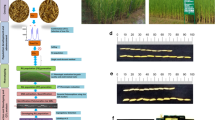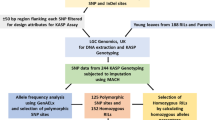Abstract
Traditional basmati rice varieties are very low yielding due to their poor harvest index, tendency to lodging and increasing susceptibility to foliar diseases; hence there is a need to develop new varieties combining the grain quality attributes of basmati with high yield potential to fill the demand gap. Genetic control of basmati grain and cooking quality traits is quite complex, but breeding work can be greatly facilitated by use of molecular markers tightly linked to these traits. A set of 209 recombinant inbred lines (RILs) developed from a cross between basmati quality variety Pusa 1121 and a contrasting quality breeding line Pusa 1342, were used to map the quantitative trait loci (QTLs) for seven important quality traits namely grain length (GL), grain breadth (GB), grain length to breadth ratio (LBR), cooked kernel elongation ratio (ELR), amylose content (AC), alkali spreading value (ASV) and aroma. A framework molecular linkage map was constructed using 110 polymorphic simple sequence repeat (SSR) markers distributed over the 12 rice chromosomes. A number of QTLs, including three for GL, two for GB, two for LBR, three for aroma and one each for ELR, AC and ASV were mapped on seven different chromosomes. While location of majority of these QTLs was consistent with the previous reports, one QTL for GL on chromosomes 1, and one QTL each for ELR and aroma on chromosomes 11 and 3, respectively, are being reported here for the first time. Contrary to the earlier reports of monogenic recessive inheritance, the aroma in Pusa 1121 is controlled by at least three genes located on chromosomes 3, 4 and 8, and similar to the reported association of badh2 gene with aroma QTL on chromosome 8, we identified location of badh1 gene in the aroma QTL interval on chromosome 4. A discontinuous 5 + 3 bp deletion in the seventh exon of badh2 gene, though present in all the RILs with high aroma, was not sufficient to impart this trait to the rice grains as many of the RILs possessing this deletion showed only mild or no aroma expression.






Similar content being viewed by others
Abbreviations
- AC:
-
Amylose content
- ASV:
-
Alkali spreading value
- ELR:
-
Cooked kernel elongation ratio
- GL:
-
Grain length
- GB:
-
Grain breadth
- LBR:
-
Grain length to breadth ratio
- SSR:
-
Simple sequence repeat
- QTL:
-
Quantitative trait locus
References
Ahn SN, Bollich CN, Tanksley SD (1992) RFLP tagging of a gene for aroma in rice. Theor Appl Genet 84:825–828
Ahn SN, Bollich CN, McClung AM, Tanksley SD (1993) RFLP analysis of genomic regions associated with cooked-kernel elongation in rice. Theor Appl Genet 87:27–32
Aluko G, Martinez C, Tohme J, Castano C, Bergman CJ, Oard JH (2004) QTL mapping of grain quality traits from the interspecific cross Oryza sativa × O. glaberrima. Theor Appl Genet 109:630–639
Basten CJ, Weir BS, Zeng ZB (2002) QTL cartographer Version 1.16. Department of Statistics, North Carolina State Univerity, Raleigh, NC
Bradbury LM, Fitzgerald TL, Henry RJ, Jin Q, Waters DL (2005a) The gene for fragrance in rice. Plant Biotech J 3:363–370
Bradbury LM, Henry RJ, Jin Q, Reinke RF, Waters DL (2005b) A perfect marker for fragrance genotyping in rice. Mol Breed 16:279–283
Chauhan JS, Chauhan VS (1994) Genetic analysis of grain dimensions and weight and their association with grain yield in rain fed rice (Oryza sativa L.). Indian J Agric Sci 64:613–618
Chen S, Wu J, Yang Y, Shi W, Xu M (2006) The fgr gene responsible for rice fragrance was restricted within 69 kb. Plant Sci 171:505–514
He P, Li SG, Qian Q, Ma YQ, Li JZ, Wang WM, Chen Y, Zhu LH (1999) Genetic analysis of rice grain quality. Theor Appl Genet 98:502–508
Huang FS, Sun ZX, Hu PS, Tang SQ (1998) Present situations and prospects for the research on rice grain quality farming. Chinese J Rice Sci 12:172–176
IRGSP (2005) The map based sequence of the rice genome (2005). Nature 436:793–800
Juliano BO (1971) A simplified assay for milled rice amylose. Cereal Sci Today 16:334–338
Juliano BO, Villareal CP (1993) Grain quality evaluation of world rices. International Rice Research Institute, Manila, Philippines
King J, Armstead IP, Donnison IS, Thomas HM, Jones RN, Kearsey MJ, Roberts LA, Thomas A, Morgan WG, King IP (2002) Physical and genetic mapping in the grasses Lolium perenne and Festuca pratensis. Genetics 161:315–324
Korol A, Ronin Y, Minkov D, Britvin E, Mester D, Korostyshevsky M, Greenspan G, Muganshtein N, Brailovsky A (1999) MultiQTL-an integrated solutions for genome mapping, Institute of evolution, Haifa university, Haifa, Israel http://esti.haifa.ac.il/∼poptheor
Kosambi DD (1944) The estimation of map distances from recombination values. Ann Eugen 12:172–175
Kumar I, Khush GS (1988) Inheritance of amylose content in rice (Oryza sativa L.). Euphytica 38:261–269
Lanceras JC, Huang ZL, Naivikul O, Vanavichit A, Ruanjaichon V, Tragoonrung S (2000) Mapping of genes for cooking and eating qualities in Thai Jasmine rice (KDML105). DNA Res 7:93–101
Lander ES, Green P, Abrahamson J, Barlow A, Daley M (1987) MAPMAKER: an interactive computer package for constructing primary genetic linkage maps of experimental and natural populations. Genomics 1:174–181
Lin HX, Min-Shao K, Xiong ZM, Qian HR, Zhuang JY, Lu J, Huang N, Zheng K, Lin HX, Min SK, Xiong ZM, Qian HR, Zhuang JY, Lu J, Huang N, Zheng KL (1995) RFLP mapping of QTLs for grain shape traits in indica rice (Oryza sativa L. subsp. indica). Scientia Agricultura Sinica 28:1–7
Little RR, Hilder GB, Dawson EH (1958) Differential effect of dilute alkali on 25 varieties of milled white rice. Cereal Chem 35:111–126
Lorieux M, Petrov M, Huang N, Guiderdoni E, Ghesquière A (1996) Aroma in rice: genetic analysis of quantitative trait. Theor Appl Genet 93:1145–1151
McKenzie KS, Rutger JN (1983) Genetic analysis of amylose content, alkali spreading score, and grain dimensions in rice. Crop Sci 23:306–311
Petrov M, Danzart M, Giampaoli P, Faure J, Richard H (1996) Rice aroma analysis: discrimination between a scented and a non-scented rice. Sciences des Aliments 16:347–360
Pinson SRM (1994) Inheritance of aroma in six rice cultivars. Crop Sci 34:1151–1157
Rabiei B, Valizadeh M, Ghareyazie B, Moghaddam M, Ali AJ (2004) Identification of QTLs for rice grain size and shape of Iranian cultivars using SSR markers. Euphytica 137:325–332
Redona ED, Mackill DJ (1998) Quantitative trait locus analysis for rice panicle and grain characteristics. Theor Appl Genet 96:957–963
Sarkar RK, Nanda BB, Dash AB, Lodh SB (1994) Grain characteristics and cooking quality of aromatic and non-aromatic, long and slender varieties of rice (Oryza sativa L.). Indian J Agric Sci 64:305–309
Singh VP, Singh AK, Atwal SS, Joseph M, Mohapatra T (2002) Pusa 1121:A rice line with exceptionally high cooked kernel elongation and basmati quality. Intl Rice Res Notes 27:25–26
Sood BC, Siddiq EA (1978) A rapid technique for scent determination in rice. Indian J Genet Plant Breed 38:268–271
Tan YF, Li JX, Yu SB, Xing YZ, Xu CG, Zhang Q (1999) The three important traits for cooking and eating quality of rice grains are controlled by a single locus in an elite rice hybrid, Shanyou 63. Theor Appl Genet 99:642–648
Umemoto T, Yano M, Satoh H, Shomura A, Nakamura Y, (2002) Mapping of gene responsible for the difference in amylopectin structure between japonica-type and indica-type rice varieties. Theor Appl Genet 104:1–8
Wan XY, Wan JM, Jiang L, Wang JK, Zhai HQ, Weng JF, Wang HL, Lei CL, Wang JL, Zhang X, Cheng ZJ, Guo XP (2006) QTL analysis for rice grain length and fine mapping of an identified QTL with stable and major effects. Theor Appl Genet 112:1258–1270
Wanchana S, Kamolsukyunyong W, Ruengphayak S, Toojinda T, Tragoonrung S, Vanavichit A (2005) A rapid construction of a physical contig across a 4.5 cM region for rice grain aroma facilitates marker enrichment for positional cloning. Sci Asia 31:299–306
Xu Y, Zhu L, Xiao J, Huang N, McCouch S (1997). Chromosomal regions associated with segregation distortion of molecular markers in F2, backcross, doubled haploid, and recombinant inbred populations in rice (Oryza sativa L.). Mol Gen Genet 253:535–545
Zeng Z (1994) Precision mapping of quantitative trait loci. Genetics 136:1457–1468
Acknowledgements
This work was done under National Bioscience Award to NKS by the DBT, Government of India. We are thankful to the financial support of ICAR through NPTC project, IARI and CSIR, New Delhi for fellowship supports to AY, and Dr. KV Prabhu for off-season multiplication of RILs in the National Phytotron Facility.
Author information
Authors and Affiliations
Corresponding author
Electronic supplementary material
Rights and permissions
About this article
Cite this article
Amarawathi, Y., Singh, R., Singh, A.K. et al. Mapping of quantitative trait loci for basmati quality traits in rice (Oryza sativa L.). Mol Breeding 21, 49–65 (2008). https://doi.org/10.1007/s11032-007-9108-8
Received:
Accepted:
Published:
Issue Date:
DOI: https://doi.org/10.1007/s11032-007-9108-8




